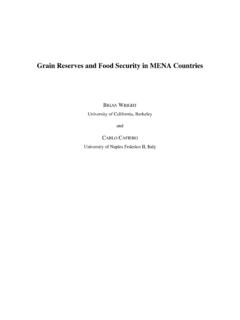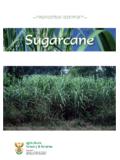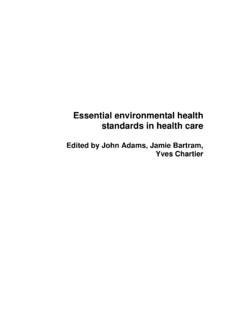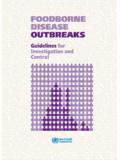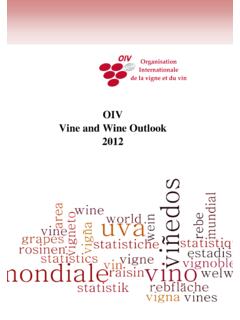Transcription of Probiotics in Animal Nutrition - Food and …
1 ISSN 0254-6019. 179. FAO Animal PRODUCTION AND HEALTH. paper Probiotics IN. Animal Nutrition . Production, impact and regulation Cover photographs Left: FAO/Sergei Gapon Middle: FAO/Roberto Faidutti Right: FAO/Isaac Kasamani 179. FAO Animal PRODUCTION AND HEALTH. paper Probiotics IN. Animal Nutrition . Production, impact and regulation food AND agriculture organization OF THE UNITED NATIONS. Rome, 2016. Recommended Citation FAO. 2016. Probiotics in Animal Nutrition Production, impact and regulation b y Yadav S. Bajagai, Athol V. Klieve, Peter J.
2 Dart and Wayne L. Bryden. Editor Harinder Makkar. FAO Animal Production and Health Paper No. 179. Rome. Authors Yadav S Bajagai, Athol V Klieve, Peter J Dart and Wayne L Bryden School of agriculture and food Sciences, The University of Queensland, Australia Editor Harinder Makkar The designations employed and the presentation of material in this information product do not imply the expression of any opinion whatsoever on the part of the food and agriculture organization of the United Nations (FAO). concerning the legal or development status of any country, territory, city or area or of its authorities, or concerning the delimitation of its frontiers or boundaries.
3 The mention of specific companies or products of manufacturers, whether or not these have been patented, does not imply that these have been endorsed or recommended by FAO in preference to others of a similar nature that are not mentioned. The views expressed in this information product are those of the author(s) and do not necessarily reflect the views or policies of FAO. ISBN 978-92-5-109333-7. FAO, 2016. FAO encourages the use, reproduction and dissemination of material in this information product. Except where otherwise indicated, material may be copied, downloaded and printed for private study, research and teaching purposes, or for use in non-commercial products or services, provided that appropriate acknowledgement of FAO as the source and copyright holder is given and that FAO's endorsement of users' views, products or services is not implied in any way.
4 All requests for translation and adaptation rights, and for resale and other commercial use rights should be made via or addressed to FAO information products are available on the FAO website ( ). and can be purchased through iii Contents Preface v Acknowledgement vii Introduction 1. Scope of the document 3. Probiotics : definition and classification 5. Definition 5. Classification 5. Micro-organisms used in Probiotics 7. Manufacture of Probiotics 11. Selection of microbial strains 11. Fermentation 11. Growth media 11. Growth conditions 12.
5 Fermentation methods 12. Drying 13. Freeze drying 13. Spray drying 13. Mode of probiotic action 15. Modification of the microbial population of the GIT: promoting favourable GIT microflora 15. Increase in digestion and absorption of nutrients 17. Production of antimicrobial substances 17. Alteration in gene expression in pathogenic micro-organisms 18. Immunomodulation 18. Improvement in innate gut immunity through restitution of intestinal barrier function 19. Stimulation or suppression of immune response 19. Colonization resistance 21.
6 Probiotic application in different livestock production systems 23. Probiotics in poultry Nutrition 23. Growth rate 23. Feed intake and feed efficiency 24. Carcass yield and quality 28. iv Nutrient Digestibility 28. Intestinal histomorphology 29. Control or prevention of enteric pathogens 29. Egg production and quality 31. Probiotics in pig Nutrition 32. Growth rate and feed use efficiency 32. Health 35. GIT microbial population 36. Probiotics in ruminant Nutrition 37. Milk yield 37. Growth 38. Nutrient digestibility 39. Health 39.
7 Rumen fermentation 42. Safety of Probiotics and potential public health risks 45. Risk associated with Probiotics 46. Assessment of risk 46. Safety of microbial genera commonly used as Probiotics 48. Lactobacillus and Bifidobacterium 48. Bacillus 49. Enterococcus 50. Antibiotic resistance associated with Probiotics 50. Antibiotic resistance in Lactobacillus 51. Antibiotic resistance in Bifidobacterium 52. Antibiotic resistance in Bacillus 52. Labelling of Probiotics used in Animal feed 55. Global regulatory status of Probiotics in Animal feed 57.
8 Codex Alimentarius Commission 57. United States food and Drug Administration 57. Generally regarded as safe (GRAS) 60. European food Safety Authority (EFSA) 60. Regulation of probiotic labelling 61. Conclusion 63. References 65. v Preface This report presents a unique and exhaustive review of the state-of-knowledge on the use of Probiotics in various Animal production systems, and their impact on Animal productiv- ity. It focuses specifically on definitions, production, mechanisms of action, applications in diverse Animal production systems, effects, safety and potential public health risks of Probiotics .
9 Also covered are the labelling of probiotic products and global regulatory status of Probiotics in Animal feed. The need for this review was prompted by the lack of comprehensive, science-based, and consolidated information on the impact of Probiotics on monogastric and ruminant animals. Given that the consumption of Animal products has increased at a high pace in the last two decades and is likely to increase substantially, especially in developing coun- tries, there is increasing pressure on the livestock sector to produce more with limited resources.
10 Two of the most important objectives for using Probiotics in Animal feed are to maintain and improve the performance of the Animal , and prevent and control enteric pathogens. In the context of the growing concern with the sub-therapeutic use of antibi- otic growth promoters in Animal feed and greater appreciation of the role of the microbial ecology of the gastro-intestinal tract in determining Animal productivity, increasing num- bers of probiotic products are being developed and used in Animal Nutrition . The report references over 250 publications on a large number of Probiotics being evaluated, and highlights those that have promise, given their demonstrated effectiveness.











